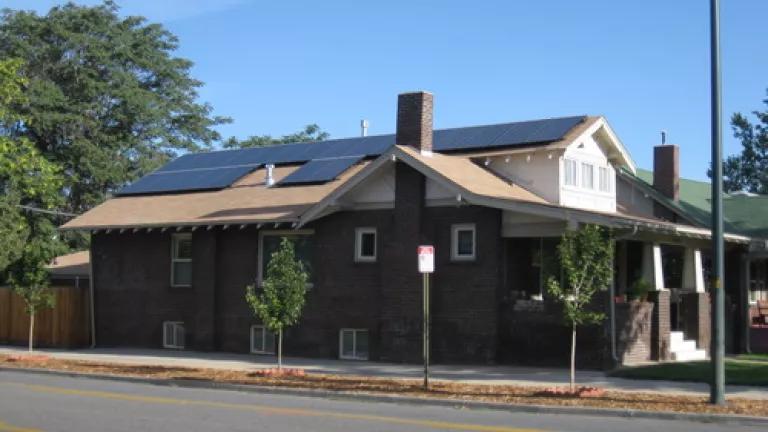
This week, New York Governor Andrew Cuomo announced $28.6 million in solar grants to be awarded under New York’s innovative NY-Sun Initiative, the governor’s landmark effort designed to build the state’s solar industry and drive down costs—to make solar more affordable for all of us. (A pivotally important attempt to extend NY-Sun through 2023 is now before the New York State Public Service Commission. More on that further down in this post.)
True to NY-Sun’s mission to drive down the so-called soft (non-hardware) costs of solar—costs that are a fraction in Germany of what they are here in the U.S.—on Tuesday, the Initiative announced several exciting projects that involve collective purchasing in New York City, Westchester, the Capital area and the Finger Lakes.
Gov. Cuomo's NY-Sun Initiative is now supporting solar collective purchasing programs. Such programs can save participating homeowners as much as 20 percent. The family that owns this Colorado home purchased solar through the collective Solar Benefits Colorado effort. (photo: The Vote Solar Initiative)
Collective purchasing is the aggregating of interested customers to build community support for installing solar, to provide technical expertise, cut costs and ensure quality. Around the country, programs like these, many of them based on the Solarize model, have reduced the cost of solar for participating customers by an important 10-20 percent, making clean energy surprisingly affordable for homeowners and others who thought it far out of reach.
Sharing one of these NY-Sun grants are two New York City solar powerhouses—Solar One, whose mission is to help create more sustainable and resilient urban environments, and Sustainable CUNY, which harnesses the City University of New York’s brainpower to help make New York a healthier, better place to live. (You can see that brainpower in action by checking out its mind-blowing NYC Solar Map. The map allows anyone in the five boroughs to type in their address, and, with the click of a mouse, calculate their home or business’ solar potential, along with annual energy cost savings, return on investment, local, state and federal incentives, and carbon reductions. It’s stunning.)
Last year, Solar One piloted two relatively small collective purchasing programs—one called Solarize Brooklyn, for homeowners, and another with the Jewish Greening Fellowship, for synagogues and community centers. Together, they helped knock down the cost of a participating residential solar system by a significant 500 bucks. Now, with Sustainable CUNY’s help, they’re ready to go big. “The goal is to come up with a long-term, affordable model for many residents of New York City,” says Esther Siskind, Solar One’s Director of Programs.
Toward that end, the two groups are analyzing how best to scale-up, not just for homeowners but for “business and industrial users as well,” Siskind says. Sustainable CUNY will integrate Solar One’s collective purchasing programs into its Solar Map.
Another program funded Tuesday will bring to New York state the GroupEnergy program pioneered out West by our friends at the advocacy group Vote Solar. It brings together employers, their employees and others to “build solar awareness and lower solar soft costs in one fell swoop,” explains Program Director Jessie Denver.
Called NY Solar Smart—SunShares, and with some help from Sustainable CUNY again, this program will offer solar at a reduced cost to employees of Pepsico, the City of Albany, the New York State Department of Environmental Conservation, and the New York State Office of Parks, Recreation and Historical Preservation—about 48,000 people in total—with potentially more employers to come.
In 2013, GroupEnergy ran programs that resulted in “about a 20 percent decrease in the cost of installation,” Denver says.
These efforts aren’t restricted to the Big Apple, by the way: collective purchasing program in New York’s central region and Westchester County got funding as well.
Part of the beauty of these programs is that they don’t just drive down solar costs for participants but tend to decrease solar costs in the areas in which they operate by creating increased competition and by bumping up economies of scale. “Programs like these have seen spillover effects, and other installations in these areas have seen an uptick, too,” says Jeff Irvine, one of the New York City Solar Ombudsmen at Sustainable CUNY.
With NY-Sun funding these and other innovative, cost-cutting projects, it only makes sense to extend and expand the Initiative; it shouldn’t expire at the end of 2015 and take all its market-transforming potential with it.
NYSERDA, the state agency that runs the NY-Sun Initiative, is seeking the approval from the New York State Public Service Commission—the state’s energy regulator—to extend NY-Sun for ten years and invest $1 billion to support solar. NRDC and our many solar, environmental and greentech allies have encouraged the public to weigh in and have submitted formal comments to the PSC. We urge the Commission to continue the important work of NY-Sun by extending the program as proposed.

